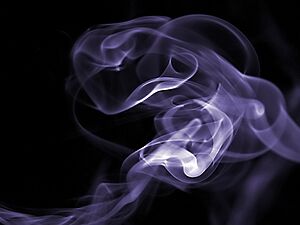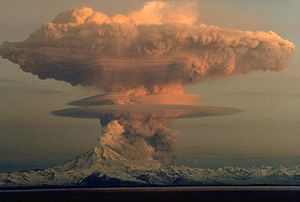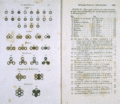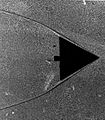Gas facts for kids
A gas is one of the main states of matter, like a solid or a liquid. In a gas, tiny particles called molecules move around freely. They are not attached to each other at all. This is different from a liquid, where molecules are loosely connected. It's also different from a solid, where molecules are held tightly together.
A gas can be made of different things. It might be a single atom, like neon gas. Or it could be molecules made of the same atoms joined together, like hydrogen. Some gases are made of different types of atoms joined, like carbon dioxide.
Gases can also be a mixture of different types. For example, air is a gas mixture. It is mostly nitrogen (78%) and oxygen (20%). It also has small amounts of argon and carbon dioxide.
Some gases have been used in wars, but this is now banned.
Contents
What are the physical characteristics of gases?

All gases can flow, just like liquids. This means their molecules move independently. Most gases, like hydrogen, have no color. Gas particles will spread out, or diffuse, to fill any container they are in. This could be a bottle or a whole room.
Compared to liquids and solids, gases are very light. They also flow easily. We cannot see most gases because they have no color. But we can measure how heavy they are. We can also measure their size, how hot or cold they are, and how much they push.
What is gas pressure?
Pressure is how much force something pushes on another object. For a gas, this is usually the gas pushing on its container. Or, if the gas is heavy, it pushes on things inside it. Pressure is measured in units called pascals.
We can change the pressure of a gas. If you squeeze a bottle with air inside, you make the air inside have more pressure. A lot of gas in a small container will have very high pressure. A small amount of gas in a big container will have low pressure.
Gas can also create its own pressure. This happens when there is a lot of it. The weight of the gas pushes down on everything below it. On a planet, this is called atmospheric pressure.
What is gas temperature?
The temperature of a gas tells us how hot or cold it is. In physics, temperature is often measured in kelvins. But degrees Celsius are used more often in daily life.
In a gas, temperature is linked to how fast the molecules move. The faster gas molecules move, the more they crash into each other. These collisions release energy, which we feel as heat. If the area around the gas gets hotter, the gas particles will move faster. This makes the gas hotter.
How do gases change state?

A gas can change into other states of matter. If the temperature gets low enough, a gas can condense. This means it turns into a liquid. Sometimes, if it gets very cold, a gas can go through deposition. This is when it changes straight into a solid.
Usually, a gas first turns into a liquid, then the liquid freezes into a solid. But with deposition, it skips the liquid step. Frost on the ground in winter is an example of this. Water vapor (a gas) in the air gets very cold. It then instantly turns into ice because of deposition.
Related pages
Images for kids
-
Dalton's notation.
-
Satellite view of weather pattern in vicinity of Robinson Crusoe Islands on 15 September 1999, shows a turbulent cloud pattern called a Kármán vortex street
-
Delta wing in wind tunnel. The shadows form as the indices of refraction change within the gas as it compresses on the leading edge of this wing.
See also
 In Spanish: Gas para niños
In Spanish: Gas para niños








